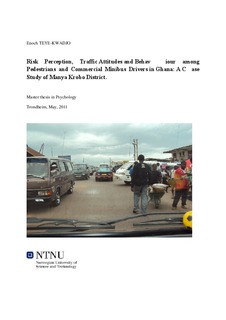| dc.description.abstract | Road traffic accidents have become ‘hidden epidemics’ across the world and have posed a substantial health and economic burden to many developing nations. In 2006, Ghana spent US$ 165 million (1.6% of GDP) on accident management. On average, five (5) people die and several others are injured on the country’s roads daily. In about 95% of road traffic crashes in the country, human factors have been implicated. Available evidence indicates that the casualty rate is on the rise in many parts of the country. However, little attempts have been made to understand the individual and situational determinants of road traffic crashes among drivers and pedestrians. Employing a qualitative research methodology, this research investigated drivers and pedestrians’ opinions about their traffic risk perception, attitudes and behaviour and their relationship with motor vehicle crashes with the overall goal of identifying and describing the proximal and distal factors of accident causation in the Manya Krobo area. Two sub-studies make up the content of the present research: The first study explored the individual and situational determinants of aberrant driving and traffic crashes among commercial drivers of passenger-carrying minibuses. Challenging working conditions, road rage behaviours, inadequate driver training, bad road infrastructure and equipment, and passenger distractions were among the reasons described for dangerous driving. Other motivations were risk-taking propensity, fatalism, and ineffective traffic law enforcement.
In the second study, pedestrian road use attitudes and behaviour as well as their travel experiences in relation to pedestrian-vehicular crash involvements were investigated. The major behaviours reported to be influencing pedestrian-vehicle crashes included pedestrian-unfriendly road infrastructure, nearness of stores and supermarkets to major roads, risky pedestrian road use behaviour, aberrant driving, street hawking, parental negligence, and general disinterest in pedestrian law enforcement. Given the importance these findings may have for central government, road planners, and safety officials; discussions have been made and recommendations for accident countermeasures have been put forward.
Keywords: Ghana; Pedestrians; Commercial drivers; Risk perception; Attitude; Behaviour; Streethawking; Driving apprenticeship | nb_NO |
